Dear Diary Ain't Oh-Eight No More

(LONG … LEWAN)
Dear Diary,
Last October, in an effort to get a better handle on what our starting defense looked like compared to past defenses, I put together a depth chart-long “You Might Remember Our Starters from Such Players As…” comparison…thingy. At the time people requested a second version for the offense, but I figured what’s the point? The active period I was pulling YMRMFSPAs was ’96 to ’07, when the offense was substantially different that that of 2010.
Well now that’s changed, and other than talk about the Class of ’11 recruits (about which among the MGoTeam I’m the least qualified) we’re in a dead period where there’s not a lot to muse upon. On the other hand, finding comparisons among the DeBord/Malone band of Daves (Pearson, Baas, Petruziello) for a roster generated in three years of heavy Rodriguization is going to lead to some very non apple-y conclusions. I’m going to need some help in the comments for nominees before I put that together. For now, here’s a projected depth chart:
(Returning starters in bold, * means redshirt, all images courtesy of MGoBlue.com.)
Backfield:
Offensive Line:
Note on O-Line: The backup situation is anybody’s guess. This blogger’s guess is that Barnum replaces Schilling, but Khoury is in the mix as well. An injury to either tackle could mean Schofield replaces them or Omameh slides over and a guard moves in. Khoury is probably the first guy in at any guard or center position, and has been a center thus far, but I slid him over only so we could mention Pace.
Receivers:
| X | Y | Z (Slot) | Tight End |
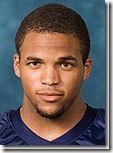 Darryl Stonum (Sr) |
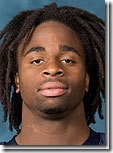 Martavious Odoms (Sr) |
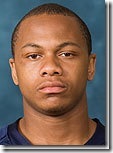 Roy Roundtree (Jr*) |
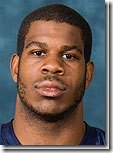 Kevin Koger (Sr) |
| Junior Hemingway (Sr*) | Jeremy Jackson (So), et al. | JeRon Stokes (Jr) | Brandon Moore (Jr*) |
Note on Receivers: I wouldn’t know where to begin if I ran everybody here. Hemingway might as well be a starter too. I’m basing this off of the concept of the 2003-’07 three-wide offense but chances of this being the depth chart are slim. Left out are Kelvin Grady, Terrence Robinson, Ricardo Miller, Jerald Robinson, D.J. Williamson, Jeremy Gallon, Drew Dileo, any of whom could play this year.
We’ll get to candidates in a moment. Before that, though, let’s just sit back and enjoy something here: this is the best-looking offensive depth chart we have seen since 2000. Better than 2007, since there aren’t any Mitchells, Ciullas, or freshman Borens and Schillings anywhere to be found. Not to sound too Jacksonian, but the best way to describe this depth chart is 2003, only faster.
…and a hell of a lot smaller.
Sizing Pegs
This roster is pretty much the exact opposite of the 2010 defensive depth chart, and likewise the exact opposite of the 2008 offensive depth chart, and likewise the exact opposite that day your favorite pet died. There are longtime returning starters and upperclassmen who have played at a high level all over the place, from the stocked receiver corps to the junior quarterback who spent the first half of his first year starting as the presumptive Heisman frontrunner.
The Possibly Depressing Thing: Rich Rodriguez and Calvin Magee spent three years finding all of these round pegs to fit his offense’s round holes. The stupid but ultimately irrepressible meme of the 2008 offense was that Rich Rod was trying to play an offense that didn’t match the talent. That was true for the Loeffler-ish quarterbacks* but nobody else – we are talking about a team playing a total of one guy (Greg Mathews) at the same position he had occupied the previous year.
------------------------------------
* That means Threet and Cone; I really don’t want to get into Mallett again here.
------------------------------------
Let’s examine those round pegs, and the concerns they present:
The O-Line Are a Bunch of Zone Pansies
Borges says he plans to run an offense that best fits the talent on hand. On the other hand, Brady Hoke seems to favor man blocking over zone (a meme based mostly on a San Diego columnist that (the meme) makes user S.G. Rice go “ARRRRRRRRRRRRRGH”). Hoke’s disdain for the spread is probably overblown (and the suggestion he means to make us into Wisconsin even more so), but neither does anyone think he’s planning to run the spread ’n shred. Which means that to a degree, these players may have some edges exposed when they’re inserted into square-ier holes. That starts on the offensive line, where the last transition didn’t go so well.
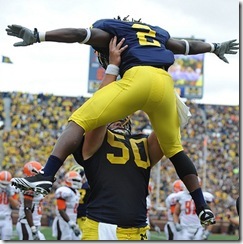 The story of the 2008 offensive line was the coaching staff being so desperate to sit McAvoy they inserted a fall position switch DT at guard, and Angry Michigan Offensive Line Hating God parrying with successive injuries to Zirbel, Huyge, Schilling, Dorrestein, Molk, and several lawn chairs before Rodriguez/Magee/Frey finally cried uncle.
The story of the 2008 offensive line was the coaching staff being so desperate to sit McAvoy they inserted a fall position switch DT at guard, and Angry Michigan Offensive Line Hating God parrying with successive injuries to Zirbel, Huyge, Schilling, Dorrestein, Molk, and several lawn chairs before Rodriguez/Magee/Frey finally cried uncle.
Brian said this in the 2008 preview when the position’s Angry Hating God was just getting underway:
“The line took a hit it could not afford to sustain when certain starter and once upon a time touted recruit Cory Zirbel went down with a knee injury, forcing either David Molk or hastily converted defensive lineman John Ferrara into the starting lineup. Michigan is now one injury away from serious issues indeed.”
…penned a ‘Decline and Fall’ declamation after just one game:
“Blame goes to Carr, who recruited so erratically, Andy Moeller, who was the line coach, Rodriguez, who has no family values, and whoever was identifying linemen to go after. To me this list goes “miss, miss, miss, miss, miss, Schilling maybe, miss, miss, miss, miss, guys Moeller couldn’t destroy.”
…and in the position’s post-mortem, gave a positive review to all of one guy on the entire unit: redshirt freshman David Molk. That’s the same David Molk who will be your 5th year senior, 4th year starting center this year. The other guy who showed promise on the field in ’08: Huyge, who four years later (and with no discernible regression) is projected to be either our worst offensive lineman, or backup to a hyped redshirt sophomore whose time has come.
Molk and Huyge were the first two guys recruited when Carr took us to zone blocking. Molk especially turned out to be great at using his agility to open up the Spread ‘n Shred. He has come a long way from the time Penn State linemen were picking him up and depositing him in the backfield. Huyge at tackle has been just a guy. To them have been added Omameh, who struggled inside at times as a redshirt sophomore but has a true knack for knocking defenders’ heads together on the 2nd level; and Taylor Lewan, now entering his (RS) sophomore season, who claims to be a clone of Jake Long and just might be. Ricky Barnum, who saw some playing time last year, is probably the guy who most looks like a typical Hoke blocker, but his recruiting pedigree said agility. The staff kept after Rod’s similar recruits. Guys, I don’t think this is becoming the Wisconsin line, or at least it isn’t this year.
The Wisconsin game last year might be instructive, since RR ran a more “nose to nose” blocking. If you’ve suppressed that game from memory, here’s how the blocking turned out:
| Offensive Line | ||||
|---|---|---|---|---|
| Player | + | - | T | Notes |
| Huyge | 2.5 | 0 | 2.5 | Run game seemed to tilt the other way. |
| Lewan | - | - | - | DNP |
| Schilling | 5 | 2 | 3 | |
| Molk | 7 | 1 | 6 | No reaches but some good blocks otherwise. |
| Omameh | 10.5 | 3 | 7.5 | Surprisingly the focus of the run game. Executed a lot of grinding double teams. |
| Khoury | - | - | - | DNP |
| Dorrestein | 4.5 | 5 | -0.5 | Pretty meh. |
| Webb | 2 | - | 2 | The usual |
| Koger | 2 | 2 | 0 | Also the usual. |
| TOTAL | 33.5 | 23 | 20.5 | Solid blocking day. |
You can open your eyes now. Look up…yeah, see? “Solid blocking day.” The worst guy was Dorrestein, who’s now gone. Lewan didn’t play, and this we said was bad. Note Omameh’s “executed a lot of grinding double teams” and Molk’s “7-1-6” day without any of his signature reaches.
Denard Isn’t Built for This Offense

The tea leaves (important: at this point all we have to go on is tea leaves, which are nearer in predictive accuracy to banana peels than facts) suggest the plan to deploy Denard is something between Frank Beamer’s use of Michael Vick, and “run around and stuff.” The upside might be something akin to 2006 Ohio State, when diminutive Troy Smith won the Heisman on lucky, back-shoulder tosses to guys better than Junior Hemingway but not that much better. Among the weaker points in Denard’s game:
- Accuracy? I went back to the formula I used for Data-Mining the HenneChart, an early 2009 “Wow Tate” piece that might give some perspective. I didn’t want to go over the whole thing again, but I plugged Denard’s 2010 season through Wisconsin (last game UFR-ed) and tried to pull some useful things out of it. Results:
Per 100 Attempts:
| Quarterback (Year) | Dead-On | Catchable | Marginal | Incomplete | Bad Read |
| Robinson (2010) | 11.65 | 53.82 | 4.82 | 14.06 | 4.82 |
| Henne (2006) | 15.86 | 49.31 | 0* | 12.07 | 6.21 |
| Henne (2007) | 8.91 | 54.66 | 0* | 19.03 | 4.45 |
| Mallett (2007) | 10.06 | 36.48 | 0* | 23.90 | 10.69 |
| Threet (2008) | 6.93 | 41.99 | 2.60 | 19.48 | 9.09 |
| Sheridan (2008) | 4.55 | 51.82 | 5.45 | 17.27 | 10.00 |
Sorry I didn’t include 2009 – I only have partial info for that. The star is because Brian didn’t chart marginals before 2008. The thing to notice is that out of 100 throws, the Incompletes for Denard were really low – closer to Henne’s best year. Those are given out for winging uncatchable passes. Also the bad reads are spectacularly low, almost as good as Henne’s senior year. At this point, however, you are screaming at me because “threw two steps behind his receivers in end-zone to cue Day of the Jugalos.” From that UFR:
That success rate has to be wrong.
It's not wrong, it just doesn't weight passes based on how damaging the particular inaccurate ball is. Against MSU, Denard threw the following balls not to his receiver:
- Endzone interception #1 on route Roundtree had two steps on. [Zero points]
- Wide open Stonum on fly route about 20 yards downfield that's airmailed. [Three points]
- Hitch to Odoms on second and nine from the 11 that would have been first and goal. [Zero points]
- Endzone interception #2 on slant that Hemingway was open on. [Zero points]
- Covered slant zinged over Grady [Zero points]
- Bubble too far in front of Roundtree. [Seven points]
- Other interception on route where Grady had plenty of room to the inside of the field but the ball was way, way too far outside, allowing sinking corner to react and intercept. [Zero points]
How big of a deal is it to throw a bubble screen a step in front of a receiver? One unit of big deal. How big of a deal is it to throw a makeable 20 yard touchdown over someone's head on third and three? Two, three units of big deal. How big of a deal is it to throw endzone interceptions when you have open receivers? Five units of big deal.
The reason the rate is the rate is because a bad pass is a bad pass; in reviewing a performance we're trying to strip out the emotion from the game and use it as a predictive measure. If Robinson had thrown those balls out of the endzone instead of behind the receivers Michigan would have had maybe seven more points but the QB play would have been equivalent.
- So continuing with this bullet, there isn’t evidence that Denard is inaccurate. On the contrary, he’s among the most accurate passers we have had in the UFR era. I would suggest that fear of Denard’s legs make his reads a lot easier, but then again, they’re his legs. When I run the rest of the metrics from ‘Data-Mining’ Denard jumps out as Michigan’s best passing quarterback by far, with attempts comparable to a full Henne year. That threat isn’t taken away unless Borges trains him to sit in the pocket with timer like Henne – and no, he’s not going to do that.
- Scrambling. Through Wisconsin Denard had four charted scrambles. Most of the time he kept the play alive and looked downfield. Often this led to bouts of, to paraphrase something I’m sure Brian wrote, “Run! Run! Run Damn You!” [Faerie Magic] “YAY!” It’s hard to complain too much when this ends with Junior Hemingway dipsying around four Illinois defenders at the sideline for an unlikely touchdown, but maddening nonetheless. Perhaps if he’s not counted on to run the ball as much, plus with another year of experience, Denard will take greater advantage of his speed when the holes are there.
- Size. Yes. I ended up talking myself out of the first two pretty handily but that ends here. This is Denard’s problem, and it will be more of Denard’s problem in a West Coast offense, because he starts his sidearm-y throws a good foot below where the tropospheric statues of yore released the ball. This is why passes zinged over wide open Stonum 20 yards downfield when pressure broke through. It’s also probably why Robinson’s dilithium seemed to get diluted later in the year, as his small frame took pounding after pounding. He’s a tough sonofabitch, but also took a lot of shots to his throwing shoulder from other tough sonsofbitches.
The Receivers Are Too Small
A few years ago, I suggested Rodriguez’s secret plot to develop a vertical game. A lot of attrition followed, but then were replaced by plenty of targets, meaning whatever Rich Rod was up to, he didn’t just stock the cupboard, but filled an entire larder. The concern, of course, is that he stocked it with lots of smurfs on jetpacks, or slot ninjas, or midgets on rollerskates, or pick your trochee-containing metaphor. Let me show you something:
| Ht | Wt | Ht | Wt | |
| 6'1 | 207 | 6'0 | 176 | |
| 6'1 | 205 | 6'2 | 195 | |
| 5'11 | 183 | 6'1 | 225 | |
| 6'4 | 233 | 5'8 | 175 | |
| 6'1 | 215 | 6'3 | 203 | |
| 6'0 | 195 | 6'0 | 193 | |
| 5'11 | 205 | 6'1 | 199 | |
| 5'10 | 178 | 5'10 | 176 | |
| 6'4 | 210 | 6'4 | 217 | |
| 6'2 | 205 | 6'1 | 178 | |
| 5'11 | 170 | 5'8 | 188 | |
| 6'3 | 205 | 5'9 | 176 | |
| 5'10 | 186 | 5'10 | 172 |
The right side is Michigan’s projected 2011 depth chart:
| Ht | Wt | Name |
| 6'0 | 176 | Roy Roundtree |
| 6'2 | 195 | Darryl Stonum |
| 6'1 | 225 | Junior Hemingway |
| 5'8 | 175 | Maravious Odoms |
| 6'3 | 203 | Jeremy Jackson |
| 6'0 | 193 | Je'Ron Stokes |
| 6'1 | 199 | Jerald Robinson |
| 5'10 | 176 | Kelvin Grady |
| 6'4 | 217 | Ricardo Miller |
| 6'1 | 178 | D.J. Williamson |
| 5'8 | 188 | Jeremy Gallon |
| 5'9 | 176 | Terrence Robinson |
| 5'10 | 172 | Drew Dileo |
As for the left side, it’s the Top 13 receivers in FCS last year by total yards:
| Ht | Wt | Name |
| 6'1 | 207 | Greg Salas, Hawaii |
| 6'1 | 205 | Justin Blackmon, Oklahoma St. |
| 5'11 | 183 | Ryan Broyles, Oklahoma |
| 6'4 | 233 | Alshon Jeffery, South Carolina |
| 6'1 | 215 | Jordan White, Western Mich. |
| 6'0 | 195 | Vincent Brown, San Diego St. |
| 5'11 | 205 | Kealoha Pilares, Hawaii |
| 5'10 | 178 | Aldrick Robinson, SMU |
| 6'4 | 210 | Juron Criner, Arizona |
| 6'2 | 205 | DeMarco Sampson, San Diego St. |
| 5'11 | 170 | Titus Young, Boise St. |
| 6'3 | 205 | Leonard Hankerson, Miami (FL) |
| 5'10 | 186 | Cody Wilson, Central Mich. |
They’re a bit bigger and taller than our depth chart, especially as you get lower, but remember most of 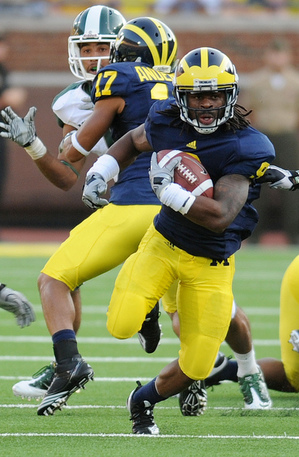 them are upperclassmen, and they were the most productive receivers in the game – our freshmen and their 2010 weights shouldn’t even be that close. And in case you’re wondering if these guys are the results of wily Air Raid systems, two I’ve highlighted played for Brady Hoke and Al Borges at S.D. State last year, and might as well have been less heralded versions of Stonum and Hemingway (except smaller, and not as fast, and against WAC corners).
them are upperclassmen, and they were the most productive receivers in the game – our freshmen and their 2010 weights shouldn’t even be that close. And in case you’re wondering if these guys are the results of wily Air Raid systems, two I’ve highlighted played for Brady Hoke and Al Borges at S.D. State last year, and might as well have been less heralded versions of Stonum and Hemingway (except smaller, and not as fast, and against WAC corners).
The tall guys like Jackson, Ricardo Miller and Hemingway should do just fine. As for the tweeners -Stonum, Roundtree, Stokes, D.J. Williamson and J.Robinson – they’re certainly within the size range of successful NCAA receivers at any school.
Among our roster players, only the bugs recruited for slot ninja will lose some value because they “don’t fit the scheme.” That means Gallon, Dileo, Kelvin Grady and Terrence Robinson won’t be as effective in an offense not designed to get them in space, unless, say Gallon, can become the kind of deep threat that forces corners into giving ground for the West Coast’s beloved stop and out routes (Grady and Robinson probably are what they are now). Odoms could be in that group too, but his effectiveness last year as an outside receiver makes me think he can thrive as that rare small guy (obvious analogue not mentioned due to Ohio State connection) in a red light/green light possession role – his downfield blocking is an unquestionable asset.
All told, this looks like a great offense no matter the scheme. Obviously they’re used to the spread ’n shred, but it’s not like taking Northwestern and suddenly asking them to play Bielema Ball. This is the opposite of 2008: If they can’t score next year, it’s on the coaching staff.
Diaries?
The good folks are still coming out of their holes after the site attack: there are four over the last two weeks and they’re all still on the sidebar, and as I’m writing this I’ve already missed most of a half of the Superbowl. Read all of them. I’m going to roll those into the next one for “of the week” purposes.
See You in Washington, Mr. President.
Congratulations on your Superbowl ring, Heisman Winner, Champion, Wolverine.
February 6th, 2011 at 11:45 PM ^
Might just be me, but none of the images are showing -- just blue ? icons.
February 7th, 2011 at 12:34 AM ^
Wasn't you. I put a band-aid on the problem (hosted 'em on my own server), but still can't get pics to post. I can see them on the FTP server but they won't show on MGoBlog.
February 7th, 2011 at 12:42 AM ^
Appreciate the effort!!
February 7th, 2011 at 12:42 AM ^
Ricky Barnum looks very hungry and is staring intently at someone holding a cheeseburger off to the side of the camera.
"Look here, Ricky, say cheeseburger..."
February 7th, 2011 at 12:58 AM ^
have the talent to win the B10 title period.
February 7th, 2011 at 9:24 AM ^
And I think our defense will be better. But the defense is still young and way less talented than the defenses at OSU and Nebraska. Also, unless Wiley is good at field goals, our special teams will be a hinderance toward a Big 10 championship.
February 7th, 2011 at 1:08 AM ^
Thank you for a lot of interesting information. But I dispute one of your main contentions:
"The stupid but ultimately irrepressible meme of the 2008 offense was that Rich Rod was trying to play an offense that didn’t match the talent. That was true for the Loeffler-ish quarterbacks* but nobody else..."
Other than that, Mrs. Lincoln, did you enjoy the show? The offense is predicated on the quarterback; if you mismatch the quarterback and the scheme -- and RR surely did that -- the whole thing is a giant fail.
February 7th, 2011 at 1:23 AM ^
I stuck a link in there to Brian's "Golden Age of Tin" article that says it better than I can.
Figure RR is the spread 'n shred guy. When he takes the reigns, if you consider Mallett already gone at this point, he has Steven Threet and Nick Sheridan. Neither is really capable of being the kind of QB who can take Michigan to the Big Ten Championship. And he has a system that has always taken at least a year of clunking around before it takes.
If we're going to hire Rodriguez and install the Spread 'n Shred, 2008 is a sunk cost. To delay the transition for a QB who whiffs 50 percent of his screen passes is just silly. It sucked for Threet, who had already been through the transfer process already and didn't deserve to have the program he transferred to ripped out from under him. But other than Threet, you're looking at a season with no returning starters on the offensive line, a new QB either way, two new RBs after a load-carrying legend departed, and in the receiver corps just one possession Y-type guy and a headcase tight end who hates nerds.
The larger failure was not recruiting a quarterback in '08 (not for lack of trying), and so dooming 2009 to the hands of a freshman. But then 2009 and 2010 would have gone a lot worse if the project hadn't started in 2008.
Ultimately, RR's offenses did exactly what they were supposed to, and exactly what was predicted: drop off the table in year 1, huge leap forward in year 2, among tops in the nation in Year 3. What doomed Rodriguez was his defense cratered at pretty much the same exact rate. Of all his mistakes, running a spred 'n shred with Threet and Sheridan in '08 was not one of them. I would agree with you, however, if you said Threet should have been the starter from Day 1.
February 7th, 2011 at 9:30 AM ^
was the only returning starter on offense. And he was a sophomore. He was an offensive lineman though.
February 7th, 2011 at 10:23 AM ^
Oops. Thank you.
February 7th, 2011 at 2:26 PM ^
I mostly see what you're saying here. I just think the abrupt scheme-change served no one's interests. It made 2008 a disaster, of course. But 2009 wasn't much better. (And 2010 wasn't nearly as great as people seem to think it was, but whatever.) A gentler transition might have made these three seasons more productive for everyone (including RR).
February 8th, 2011 at 10:31 AM ^
I respect your opinion, but I don't understand how that gentler transition would have taken place. What do RR and Magee know about running Mike DeBord's offense? It wasn't the scheme that made Boren leave. And I know this is up for debate, but even if RR was in the booth of the 2008 Capital One Bowl telling Bob Griese he meant to run the offense that best fits the talent on hand (he was, but let's pretend like he meant it), I take the position that Mallett decided he was transferring when Brian Cook was five syllables into "Peanut Butter Je..."
So... say that plays out:
RR and Magee bring in all of these slot guys then try to run the Zone-Left offense of 2007 with the following depth chart:
-
QB:
Threet, Sheridan -
RB:
Minor,C.Brown,McGuffie,Shaw,Minor,McGuffie, WE GET IT ANGRY RB HATING GOD! - FB: Moundros
-
SE:
Mathews,Babb, Rogers -
FL:
Hemingway,Stonum, Savoy -
SL:
T.Robinson, Odoms -
TE:
Butler,Massey, Koger -
LT:
Zirbel, Ortmann -
LG: McAvoy - man that sucks,
Ortmann, McAvoy...ARGH!!!!,Schilling,Ferrara,Huyge,Folding Lawn Chair,Recycling Bin,Broken Headset,DAMMIT!!! McAvoy -
C:
Molk, Moosman -
RG:
Moosman, Ferrara -
RT:
Schilling,Huyge, Dorrestein
Now imagine we tried zone-left, zone-left, zone-left, zone-left, WAGGLE!, zone-left, screen with that group. Most of the offense generated in 2008 (which ultimately had a better running game than 2007) came from Rich Rod inserting a new thing that worked until teams adjusted and we were again left at a talent deficiency. Things that worked included:
- Rock, Scissors, Paper, Candle, Paper, wait..Candle? Touchdown (ND)
- Threet Express (Wisconsin)
- Minor Rage (Penn State)
- Scoop Blocking Unleashed (Purdue)
- Ninja Molk Reach Blocks (Minnesota)
Minus that bag of tricks, I think 2008 ends up even worse. We did do some plays under center (the McGuffie sweeps versus ND were that) and a lot more NFL-like passing plays from the shotgun with Threet, but that latter usually ended in disaster because the patchwork offensive line were turnstiles in pass protection. Even when they could passblock, there wasn't a passer on the team who could throw an accurate ball. We couldn't pass because we didn't have a quarterback, and not being able to pass doomed the offense.
As with most things having to do with the Rich Rodriguez era, it was uninspiring defense and special teams disasters that ruined him. The '08 version of that was missing the game-tying field goal against Toledo, and the Shafer-ending 3-3-5 experiment that doomed Purdue. Tell me if this sounds familiar: the 2008 Northwestern game had a lot of great defensive play - career days for Mouton and Ezeh, fantastic play on the defensive line, and generally good individual play in the secondary, but three huge disasters in coverage mistakes generated all the points NW needed to pull out the Ultimate Fan Endurance game.
The offense wasn't the problem. Except for starting Sheridan when Threet was still healthy, Rodriguez did about as good on offense as you could expect with this team. By the end of the year, with injury having ravaged his RB ranks and O-Line and turned the QB depth chart into Sheridan/Feagin, the offense was actually getting noticeably better as the year went on. And come 2009 it was a lot better (but the defense had become putrid). The Rich Rod Era has nothing major to complain about offensively -- the story was spectacularly bad defensive coaching mixed with spectacularly bad luck with defensive attrition.
Anyway, I'm open to debate if you can convince me the team described above would have won more games if RR had waited to install the spread offense. I just don't see how that would have been a good offense, given the personnel, no matter what the scheme was.
February 7th, 2011 at 10:13 AM ^
"... if you mismatch the quarterback and the scheme ..."
Unbelievable ... someone went there. mackbru, you weren't on the top of that particular list, but since you took the plunge you're responsible. (Aside: I see that at least two people agree with you. One of them, surely, is the user whose name rhymes with Great Molk.)
Do you _still_ believe that cobbling a "pro-style" offense around the redshirt freshman version of Threet would have been a reasonable approach? Really? Are you aware that he was among the NCAA leaders in interceptions (http://espn.go.com/college-football/statistics/player/_/stat/passing/so…) this year as a 4th-year collegian?
- - -
As for the zone pansies, I'm concerned that they're not, at the moment, sufficiently TOUGH to play in a pro-style offense. Maybe Hoke can fix that.
/s
February 7th, 2011 at 2:13 PM ^
I think there was, at the very least, a better way to go. A middle ground. More flexibility. The system that RR put in place for Threet was way too inflexible. Is there any denying that? Seriously?
I think most good coaches would have transitioned him/the team into a new system. A transition would have helped everyone -- because, remember, the entire offense was (in addition to young and so forth) confused for most of the season. RR made them go from black to white, as opposed to black-gray-white.
Finally: You're not being fair re Threet. He doesn't have four years of meaningful experience. His first year was lost when GTech went to the option and he transferred to M. His second year was the RR spread nightmare (which in no way aided his development). His third year: transfer, ineligible. He has many practices under his belt (albeit in four different systems). But didn't play in a suitable offense until ASU.
This year -- his first experience playing in a suitable offense --he threw too many INTs. But he threw 18 TDs and put up about 400 yards against Oregon. He finished with a passer-rating equal to that of Christian Ponder and ahead of Ben Chappell, Adam Webber, Dayne Crist. He was a better-than-average starter, especially among juniors. Going into next season, he's considered one of the top 5 qbs in the Pac 10.
Threet ain't Tom Brady. But he has some talent and potential, neither of which were harnessed in 2008.
February 7th, 2011 at 1:21 AM ^
The only thing that concerns me in the slightest regarding Denard under center is the size of our linemen. In the "pro style" offense Denard will see 5 and 7 step drops that he is unaccustomed to. Rich rods offense was predicated on spreading the defense out to limit the coverages a defense can use. Most if the time Denards reads were made prior to the throw based on a number of different pre snap advantages. In the pro style offense denard is going to have to make split second reads on which coverage the defense is in. He picked up the zone read very well but coverages can be very well disguised. At the end of the dayvi think Denard will be very successful with the transition because he is an extremely hard worker and a freakish athlete with things you can't teach like vision, speed, and the ability to create. However I do think there will be some growing pains especially since his downfield success isnt the best. So excited to see what 2011 brings. Go blue!
<br>
<br>Congrats to the one and only Charles Woodson
February 7th, 2011 at 2:16 AM ^
does Pro-Style mean you take snaps under the center to pass? Or ever?
Brady, Manning? when are they under center?
The only thing that I expect to change is that Denard will not be making run option reads. Which was a play I saw less and less of in the last three games. Mostly because it seemed like it didn't work, forcing Denard to pass, and occasionally scramble.
I expect the passing routes to change, but not much. I expect the run option read to disappear. But I don't see where Denard will be under center 100% of the time.
I'm not sure if the two teams in the Super Bowl today could be classified as Pro-Style. It sure didn't seem like the QB was under center for many plays, if any. Yet somehow there were running plays where the QB handed to the running back. There were 4 and 5 receivers in formation "spreading" the defense out.
I do expect Denard to do miraculous things. Because he's still Denard.
I really think we need more than a black and white viewpoint on offensive schemes. It's as if Bo has come back to coach 3 yards and a cloud of dust. And yet, even that had changed when he had Jim Harbaugh as QB and Gary Moeller as OC.
February 7th, 2011 at 4:08 AM ^
Brady and manning are nit in pro style offenses. Please keep your nonsense away from me.
February 7th, 2011 at 4:09 AM ^
*not*
February 7th, 2011 at 12:56 PM ^
New England was in shotgun on 51% of their plays, most in the NFL. (2010 data isn't collated yet.) The Colts were right behind them, running 50% of their plays out of the gun.
They were also eighth- and third-best, respectively, comparing their offensive DVOA in shotgun to DVOA in other formations. The NFL is trending toward more use of the shotgun, at least for now, but there are still teams like San Diego that don't necessarily run a "pro-style" offense and also don't run a lot of shotgun plays.
What we probably think about as a pro-style offense - QB mostly under center, split backs and I formation - is gradually changing in the NFL. Teams are using shotgun formations and/or single- or no-back personnel more because those plays are currently working better for most teams.
NFL offenses are changing to be more like a Drew Brees-era Purdue-style spread (i.e. minus the awesomeness of QB running), but that's mostly because more of the successful teams are doing that, and the NFL is much more about copying successful teams than NCAA football is (because so much information is available and the pool of teams is so much smaller). And there are several NFL teams who can't easily be categorized: the Packers, for example, do a lot of shotgun plays (42% in 2009), but also use a full-house backfield effectively.
While I think NCAA teams can succeed with less variety than NFL teams need, I agree (I think) that the change in HC and OC doesn't necessarily mean a complete change of playbooks.
February 7th, 2011 at 4:04 PM ^
Great analysis. I agree for the most part.
The problem with using the Saints as an example for breaking the "beefcake" offensive lineman mold is they're the ones deploying massive Lloyd Boy Jonathan Goodwin at center. What they do is a bit different than what most of the NFL does, but it's not very useful to compare with an O-Line centered by David Molk.
I think the NFL's standard was on full display last night: two teams with tall QBs and massive offensive linemen throwing on three downs and running as a change of pace or to kill clock. They're facing linebackers who run a 4.5 or better and hardly ever make the kinds of mistakes that you see all the time in college ball. But the one thing all of that defensive speed still can't combat is a deadly accurate quarterback, against which their most effective defense are freak defensive ends who cut down on the time the QB has in the pocket. The shotgun, then, is a means of extending that pocket time by a little bit longer, but then the running game suffers by putting the ball so far from the line of scrimmage.
What's great about the RR offense is it found a way to run from the shotgun. Unfortunately for the NFL, it's not that great unless you are willing to use your quarterback as a primary rusher, which not my $13 million investment!
February 7th, 2011 at 7:58 AM ^
In any transition there are growing pains, they are unavoidable. Thankfully, the front end of our schedule is a little easier than the back end. Maybe we have room for a few of those errors? I don't want to take any game for granted, but I'd rather make a few mistakes against the likes of Western Mich and Eastern than say, Nebraska.
February 7th, 2011 at 1:26 AM ^
The OL may not be zone pansies but can they pass protect?
February 7th, 2011 at 1:48 AM ^
Good point, and I should have addressed that.
...I mean, I have no answer.
That's a really f-ing good point. And I really should have addressed that.
I mean, if the gameplan is to passblock a ton (like the best NFL teams these days), the name of the game is size -- huge immobile objects to create a pocket for giant gunslingers to pick laser-thin margins in Cover 2 defenses. Did they even run in the 2nd half more than like twice?
This team isn't built to do that. Eventually, perhaps we will be. But for 2011 there is a ton of talent on hand and it's built to run the ball well. So long as we have Denard back there (and probably Devin too), the line won't need to hold a pocket so much, because if edge rushers get run out of contain, suddenly a linebacker is one-on-one in space with a much better athlete -- and God help that LB if he's got coverage responsibility underneath.
And they're not that small. An offseason will increase this:
- Lewan: 6'8, 294
- Barnum: 6'3, 286
- Molk: 6'2, 287
- Omameh: 6'4, 305
- Huyge: 6'6, 306
...somewhat. Schofield is 6'7 and will be past 300 by fall almost certainly. Barnum too. So just Molk's the little guy, and he's stronger than any of them.
February 7th, 2011 at 2:49 AM ^
When was the last time you saw Denard step up to avoid a rush or escape a collapsing pocket and pick up a 3rd and long with his feet on a called pass play? Maybe this is what Borges was thinking of when he said Denard will be a 1000 yard rusher, but while Denard may have the physical tools to scramble his way to an 80% third down conversion rate, he doesn't seem to be an instinctual scrambler. Hopefully, I'm wrong but I wouldn't be surprised if playcalling and ineffective pass protection lead to a lower completion percentage and significant increases in sacks and INTs in 2011.
February 7th, 2011 at 3:39 AM ^
I wonder, though, if his comment about Denard scrambling more when he doesn't run so much will have validity. I think it will. Denard is a QB, so he wants to act like he plays the position, not a running back. But if he plays a QB role most of the time, perhaps he will be more inclined to go Vick on the defense, only faster. I hope so.
February 7th, 2011 at 8:30 AM ^
That's the answer.
Denard was a first year starter last year so pocket presence isn't something he's picked up yet I agree. Then again, he is hardly ever sacked because teams can't rush him without opening running lanes for him, so that's repeatable. There have been enough WoW moments of him taking off through a tiny hole, or leaping back 2 yards to give himself just enough space to hit a D.O. downfield before taking a charging linebacker...that sort of thing. When he does scramble, we usually want him to run, but he typically extends the play to the sideline. Last time I remember him doing that was Purdue -- Miss State, Ohio State and Wisconsin I don't remember him getting that much pressure, and also lots of drops and interceptions and stuff.
My thinking is Denard looked for the pass (and handed off on more ZRs than he had to) because he was starting to simply wear down with all the running. An RB takes a major pounding through the course of a season, the more so the more he runs. And Denard ran a TON in 2010. He had the 17th most carries in FBS among all players. Only Navy's QB (they run a triple option offense where the QB is basically a RB) and Cam Newton (who is a hoss) had more rushes among quarterbacks. At some point, even for Denard, something in your head hast to say "ogodnomorerushes."
February 7th, 2011 at 9:59 AM ^
...enlightening exchange. Much appreciated.
February 7th, 2011 at 10:34 AM ^
I agree MGoShoe and a very mature/level headed one at that. I remember the days when more conversations like this happened here. Recently it did seem like we have become more MLive (not Brian's fault) and I look forward to us getting back to what attracted me to the best blog site ever.
February 7th, 2011 at 1:35 AM ^
Thanks for the uber-analysis. Good to know that our team is actually, you know, good at football and not just a bunch of midget speed-freak robots programmed for zone-read and 4 WR sets.
February 7th, 2011 at 1:57 AM ^
should be on the OL depth chart. His omission illustrates how thin this position is if (when) injury bugs hit. I hope not, but we may see a burned RS for Bryant if a couple guys get dinged.
good read
February 7th, 2011 at 8:03 AM ^
Great diary. Really got me fired up for the season during a sort of news dead time.
Two things. Rodriguez himself would talk about poor execution at halftime media comment stops when we were playing good teams. It seemed like he said it every time. Maybe this team cleans that up due to a different coaching approach and just general experience. Clearly there was more to it than getting used to the system type reasoning. Executing in the big moments on key third downs against good teams would drastically change our outcomes. Our ability to become more efficient when it counts would make a massive difference in the results.
The other is turnovers. We never really improved in that area in meaningful games. As we saw, yardage totals mean nothing unless your team values the ball, especially against good teams.
February 7th, 2011 at 9:37 AM ^
When it came to poor execution, the only lineman that stood out was Lewan for his false starts. I think the fact that he will be a year older and 4 of the five lineman will have played extensively together will really help this offensive line transition to a new offense. Returning starters on an offensive line is very predictive of success.
February 7th, 2011 at 8:07 AM ^
Great post, very informative. It's all very exciting. I can't wait to see where everyone shakes out, which incoming Freshman end up with playing time (my bet is on Bryant and Barnett), and how the O-Line holds up. I'm expecting big things this year from Lewan for sure. As for the backfield, I think the scheme will take care of that. Denard is no 6ft7 Ryan Mallett, but if they roll him out, and keep him in the shotgun (which I'm sure they will) I see this as being a productive year, even if there are some growing pains at the beginning of the season. All to be expected though.
Go Blue!
February 7th, 2011 at 8:27 AM ^
I can assure you that Vincent Smith will not be starting next fall. That's the only roster spot I believe you missed.
February 7th, 2011 at 9:39 AM ^
First, that's not Brian.
Second, he is just using Vincent Smith there because Spring ball hasn't even happened yet and Smith was our starter last year. He specifically discusses Shaw and Toussaint.
February 7th, 2011 at 9:40 AM ^

I'm not Brian. Also:
and And many more. Smith is a great weapon on screens, and probably the best receiver among our current backs. For a little guy he blocks better than the other guys too. At the very least, he'll have a 3rd down role. His speed might come back; remember he was recovering from a major injury last year.
February 7th, 2011 at 8:59 AM ^
i think toissant = david underwood.
tons of promise, never healthy enough to show it.
February 7th, 2011 at 9:53 AM ^
...Ricardo Miller would be higher in your analysis as he's got the size to be more of the prototypical receiver in this offense.
February 7th, 2011 at 10:01 AM ^
...there's always a need for a possession type receiver who runs precise routes, knows where the first down marker is, and can find the seams when things break down. I'm not saying that Miller is that guy, but receivers don't all have to be tall burners.
Jason Avant anyone?
February 7th, 2011 at 10:19 AM ^
 I sincerely hope he is. I kept wanting to push him up, especially when I did the side-by-side receiver size comparision because that would have allowed me to match him with a big guy. But the scientist inside me said I have to go with the slim amount of information available, and that information says Ricardo went from being certain 5-star to a 3-star to scouts (we are guessing this was because he moved to Ann Arbor and out of SEC country), and was redshirted while Jackson (who also played in Pioneer's triple-option, passless offense in '09) got playing time as a true freshman.
I sincerely hope he is. I kept wanting to push him up, especially when I did the side-by-side receiver size comparision because that would have allowed me to match him with a big guy. But the scientist inside me said I have to go with the slim amount of information available, and that information says Ricardo went from being certain 5-star to a 3-star to scouts (we are guessing this was because he moved to Ann Arbor and out of SEC country), and was redshirted while Jackson (who also played in Pioneer's triple-option, passless offense in '09) got playing time as a true freshman.
Ricardo could be a guy the coaches realized would benefit from a year of separation from the current upperclassmen, especially after getting very little work last year. But then again, why redshirt a guy who moved to AA to train at Michigan and get a jump start on his career if he's ready to play?
This is just a scenario where we really don't know much. I want to imagine he's this guy who's going to be super awesome and took a redshirt to spend hours with Devin Gardner until they could read each others' minds, and then this year we'll see him force his way into a crowded depth chart the way Leon Hall burst into the Curry/Marlin/LeSeur group. Right now, I'm keeping expectations low just to be cautious because the hard counters aren't turning in any big readings (other the trail of sighs when he takes off his shirt).
February 7th, 2011 at 10:40 AM ^
I want to see this kid play so bad. I want him to be extremely successful on the field, if for no other reason, than his greatness of the field (in recruiting.) Imagine how powerful his message could be, to official visitors, when his passion for all things Michigan are a side note to the amazing plays and stats he puts up on the field.
I think that makes sense. At least It does in my head.
February 7th, 2011 at 10:51 AM ^
For not putting Stephen Hopkins at FB. He's a big back (like John Clay), and putting him at FB would be a waste of his talents. We can find a better FB who is great at blocking but I can tell Hopkins is going to be very good if only he is kept at HB.
February 7th, 2011 at 12:02 PM ^
I don't think Hennechart numbers translate between Lloyd and RR offenses. Football Outsiders was just talking about this the other day; traditional success metrics (like completion percentage) are quickly losing relevance as offenses push the edge of the high-percentage-pass envelope. When everyone's throwing screens and 5-yard curls to wide-open slot ninjas, the traditional measures of "accuracy" are blown out of the water. You don't need to have Sammy-Baugh-zipping-passes-through-a-swinging-tire accuracy to complete 60% of your passes anymore.
How many screen passes (theoretically, a pass that should be complete 90%+ of the time) has Denard been throwing compared to Henne? How many high-risk/high-reward downfield throws has Denard been asked to make, compared to Henne?
Overall, good start on disproving the "Denard Can't Run This Offense" meme, but maybe delve deeper into the UFRs.
Peace
Ty
February 7th, 2011 at 2:23 PM ^
Ty - thanks for your comments. All screen passes have been removed from those numbers since UFR began charting them, which aid after Henne. I should have mentioned I did that. Anyway all of the numbers there are downfield passes for Denard and Threetsheridammit. They probably help Henne but not that much because Hart wasn't a great screen target. What they don't show is coverage or depth or result (e.g. That denard's inaccurate balls ended up being ints in the end zone or flying over wide open receivers deep. Denard certainly got easier throws as the coverage adjusted to his running and that is reflected in the few Bad Reads. I am away from a computer this moment but "in" should be inaccurate balls not incomplete. Sorry about that.
February 7th, 2011 at 4:12 PM ^
the best thing that ever happened to Denard.
I think he's about to become a complete QB, and since they're not stupid, they will always draw up design plays that give Denard that small "option" to run. The new coaching change will effect guys like Vincent Smith, who I just never saw as a BIG 10 RB to begin with, and I doubt he plays much from here on out... 5'6, and a buck seventy isn't going to cut it - I'm sorry, though I like the options we have in Cox, Toussaint, and Hopkins. I think we'll be fine at WR, and with a slew of good/quality options, I am sure we'll see a bunch of different looks this season, not just one basic base. Offensively, I think we'll be just as explosive as last year, if not a tad bit better. Denard will have to learn on when to pick his spots - to run, though I have confidence in him learning this quickly, just as he improved his passing from year one to last year.
February 7th, 2011 at 10:51 PM ^
Just a minor terminology note: Z is traditionally used for a flanker, not slot. "Y" would be the slot receiver, while X is the split end.
/nitpicking
February 8th, 2011 at 8:48 AM ^
Thanks!! I'll change that.
I used to have those down but three years of RR and [poof].
Question: I understand the terms (SE is on the line, FL isn't, slot has someone wide of him), but I'm not as clear on what, if any, attribute differences to expect between a WR lined up in the backfield, and one who's an end?
The way I used to remember it is "BBA," that is:
X - Braylon
Y - Breaston
Z - Avant
My guess is it has something to do with whether you want a tight end to be an eligible receiver in the formation, and therefore a Flanker is going to run routes that mesh with the TE, whereas the SE in a 3-WR formation is going to be running routes off the Slot guy. So is there a difference in emphasized skills for those positions? Would you, say, want your deep threat at SE and use the slot to open up space downfield for him, and your FL to be an Avant, running stops and slants and outs and catching everything in his direction? Or is it so complicated and based on which play you're running right now that it doesn't make any difference?
February 8th, 2011 at 9:48 PM ^
Your view on it is basically right. It's become a bit more muddied as teams have moved away from the traditional SE/FL roles in the WCO, but that's the basic difference. The split end lines up on the line of scrimmage on the opposite side of the TE, this gives you the required 7 men on the LOS and offers the advantage of being about 1-3 yards more forward (closer to his route) than a WR who is lined off of the line, such as the flanker. The benefit there is getting into a route faster and being able to block effectively to that side. The downfall is that the SE can be jammed quickly. The flanker lines up a few yards off and can get more easily into his routes. It is much more difficult to jam a WR who has more room to get to the LOS.
In terms of skill sets, they are somewhat eroding as being clearly distinguishable, but a SE generally speaking would be a bigger guy who was able to get off jams and also effectively block. As far as him being a deep threat, the ideal SE has a great combination of size and speed to effectively beat off any press coverage but also be able to stretch the field. The flanker on the other hand should be quicker (than pure speed) and a good route runner.
The reason behind it came from adapting playcalling to personnel (a novel concept now), but also from the mentality that a 4 yard run was a loss for the defense, but a 4 yard pass was a win for the defense. 4 yards is 4 yards no matter how you get it. The ability of the flanker to get open aids in opening up RBs and TEs becoming involved in the pasing game.
February 9th, 2011 at 9:53 AM ^
ThANKS
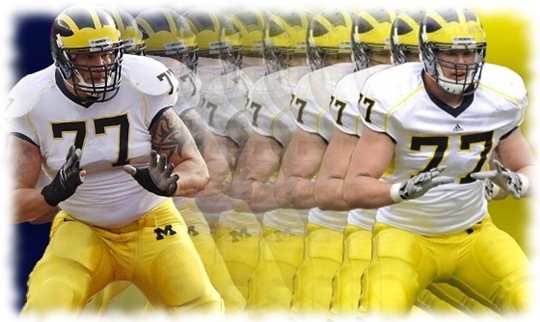
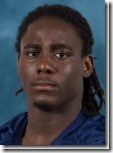
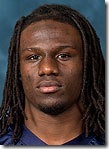
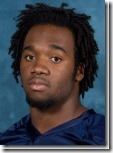
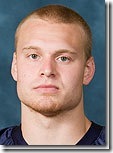
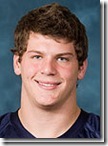
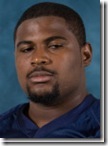
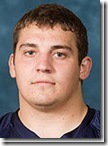
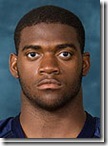
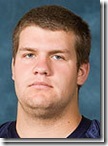
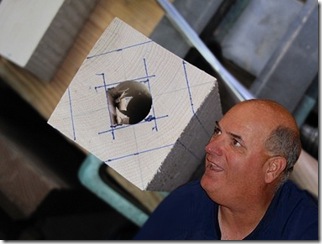
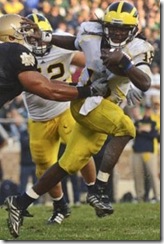
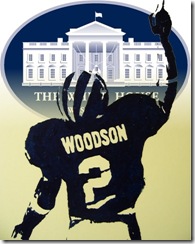
Comments